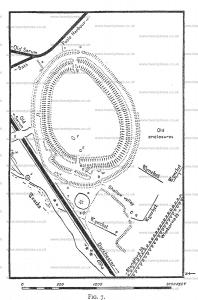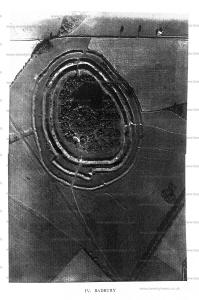Wessex from the Air Plate 4
Wessex from the Air Plate 4 is in Wessex from the Air.
Reference No. 257. County. Dorset., 25 SW. (131: G. 1). Parish. Shapwick. Latitude. 50° 49' 32" N. Longitude. 2° 3' 3" W Height above Sea Level. About 320 ft (97 metres). Geological Formation. Upper Chalk, with a small cap of Reading Beds. Time and Date of Photograph. 7.10 p.m. 14th July. Height of Aeroplane. 5,000 ft. ( 1 5523 metres). Speed of Shutter. I /90th of a second.
Badbury is one of the most beautiful of the hill-top camps of Wessex. The hill is a landmark; though only a little over 300 ft. high, and only about 100 ft. above the surrounding country, its neat round clump of pines can be seen for miles. The summit is capped by an outlying deposit of pebbly loam, thinly spread over the interior of the camp. Consequently there has sprung up a growth of brushwood, a natural covert and resort of foxes.
The defences consist of a double line of ramparts, surrounded by a third. There is a berm separating this outer rampart from the other two, but all three may be contemporary, and it is clear that the outer rampart is not earlier than the rest, for it sweeps outward to include &e protecting arm of the western gate. A similar rampart encloses the defences of Danebury. There are three gaps in this outer rampart; that at b is certainly original, and those at A and C may be. For the rest the air-photograph may be left to tell its own story. But, in addition to the defences, there are many small features of interest. Most of the interior is too thickly overgrown for observation, but a deep depression at e is undoubtedly a hut-site, and so also is a shelf at d, near the main entrance. The pond at f looks old, but may not be. By far the most striking object, however is the causeway of the Roman road and its accompanied side-banks. The causeway itself is 13 yds. wide— an unusual breadth— and the distance between the banks is 40 yds. The banks have their small ditches on the inner side in each case.
At first sight it might appear that the outer bank of the hill-fort had encroached upon and was therefore later than, the Roman road, but a close scrutiny of the air-photograph and on the spot shows that this impression is wrong. The Roman road quite clearly breaks into the ditch of the entrenchment; this is best seen in the south-west part. The wide cutting at G is later than the Roman road, for it has broken through the side-banks (what appears on the photograph to be a continuation of the south-eastern side-bank across the cutting is only a modern track). Nevertheless the cutting G is of considerable antiquity, for the tracks near H J K deliberately converge at a point (just off the plate) where the cutting ends, and one at least of these tracks is earlier than the mound J. This mound is peculiar in character, and though it has been much dug over, it is, I fancy, of the same age and character of the mounds L M N, which are Roman. It may be suggested therefore that the cutting G may be of Romano-British or slightly earlier age. If begun from the lower or north-west end, as it must have been, and before the Roman road was made, all the facts would be satisfactorily accounted for.
The conical mounds L, M and N are all three quite certainly Roman burial-mounds, erected by the side of the Roman road. The largest, N, is of oval shape and is surrounded by a curious steep little bank. The mound itself is unusually steep-sided and quite unlike the burial-mounds of the Bronze Age. It has the appearance of a large pile of earth that has been tipped there; the mound makes a sharp angle with the natural surface at its foot, quite unlike the smooth curve of a prehistoric barrow. There is no record of the opening of the mounds, and their present appearance suggests that they are intact; the author of that strange book The Barrow Diggers (London, 1839) says, however (p. 62), that 'they appear to have been opened'.

At the top of the plate the curve of the Poole Road is just discernible, but the branches to the north are invisible. On the ground they are plain, and in the same field may be traced without difficulty the junction of all these roads. The writer examined them in March 1919, and was the first to discover and record the course of the Bath Road between Badbury and the Salisbury-Blandford Road,

To the south and south-west of the hill-fort are remains of 'Celtic' cultivation. One of the lynchets (K P) is clearly older than the Roman road, for it reappears beyond it. Old enclosures have no doubt obliterated the remains here to some extent, and the parallel marks of the plough are plainly visible on the plate. Strangely, however, the character of the turf is not such as to suggest recent disturbance of the soil; possibly a rainwash of loam from the Tertiary cap may be responsible for this rapid regeneration. Between the 'shallow valley' and the Roman road is an irregular enclosure of Romano-British date. It conforms to the Roman road, and within it a few Romano-British relics were found by sporadic and very cursory trowel-digging. A station is certainly missing from the fifteenth Itinerary of Antonine. The meeting-place and aiming-point of four roads cannot have been without some kind of settlement, whether mentioned in the Itinerary or not, and it was probably located here.
Outside the Romano-Britsh enclosure at a is a small rectangular pillow-mound: and on the north side, in the triangle between the hill-fort, the enclosure, and the Roman road are three mounds. R is a large disc-barrow, somewhat flattened and irregular; S is a small barrow earlier than the enclosure; and T is a curious long mound, of irregular shape and older than the Roman road. V and W are mounds, probably barrows, partly covered by and older than, the ramparts of the hill-fort. It seems as if there had been a small group of barrows like those on Oakley Down before the camp was made or the Romans came.
X and Y are enclosure-banks of comparatively recent origin.
Gough records the discovery here in 1665 of 'Roman coins, urns, and a sword'. Another 'sword' in the Durden Collection was described by Sir John Evans; it is now in 'the British Museum. It should more properly be described as a rapier, and is 23½ in. long and 2 9/16 at the base above the rivet-holes. Mr. Syer Cuming records that it was found in ploughing, 22nd November 1851, about 100 yds. from, and in front of, the principal entrance of the camp, not within the camp, as wrongly stated by Sir John Evans.
Hutchins records the finding of the remains of Roman buildings 'within a hundred yards of the camp, not within the camp, as wrongly stated by John Evans.

It was at Badbury that Ethelwald assembled his band of adventurers in 901; he was supporting a claim to the throne of Wessex, vacant by the death of Alfred the Great. The rising, however, was unsuccessful. Perhaps this isolated and temporary occupation of the old camp was responsible for Leland's idea that the Saxon kings had a castle at Badbury; that statement is clearly incorrect, for it is plain that Leland regarded the existing ramparts as of Saxon age. Badbury last figured in history in 1645, when the Clubmen of Wilts and Dorset (4,000 strong) issued from it their proclamation against the Cromwellians.
In its later days Badbury is thus associated with lost causes. A claim has been made by Dr. Guest that it was the scene of King Arthur's great defeat of the Saxons at the end of the fifth century or beginning of the sixth.l This battle was called by Gildas Mons Badonicus The claim is based on similarity of name; but it is quite impossible that the Baddan byrig Of the Anglo-Saxon Chronicle can be connected with Badonicus.
Badda was a fairly common OE. personal name; and the name of Badby in Northants was originally identical in form with that of Badbury. Professor Stenton, whose help on the philological side I wish to acknowledge, points out that there are equal objections to connecting Badonicus philologically with Bath. The site of the battle, therefore, still remains unknown; but wherever it was, there is no more reason to associate it with Badbury than with, say, Hod Hill, or any of the other hill-forts of Southern England.
O.G.S.C (age 41).
LITERARY REFERENCES
Leland's Itinerary, iii. 54.
Gough's Camden, 1806, vol. i, p. 73.
Colt Hoare, Ancient Wiltshire (Roman Era), pp. 35—6.
Hutchins's History of Dorset, 3rd ed., 1868, vol. iii, pp. 175-7.
H. Syer Cuming, journ. Brit. Arch. Assoc., 1859, p. 228, Plate 23, fig. 1 (rapier).
Sir John Evans, Ancient Bronze Implements, 1881, p. 250 (rapier).
A. Hadrian Allcroft, Earthwork of England, 1908, pp. 108—10.
Heywood Sumner, Ancient Earthworks of Cranborne Chase, 1913, pp. 18—20 (plan, Plate 4).
E. Guest, Origines Celticae, vol. ii.
J. C. Mansel-Pleydell, The Roman road from Badbury to the Wiltshire boundary near Ashmore 9, Proc. Dorset Field Club, vol. ix, 1888.
J. H. Austen, 'Some Vestiges of Roman Occupation in Dorset ', joum. of the Brit. Arch. Institute, vol. iv, 1867.
C. Warne, Ancient Dorset, 1872, pp. 34—8.
Proc. Dorset Field Club, xxvii. 1—11 (Walter Fletcher); xi. 16—26 (T. Wake Smart).